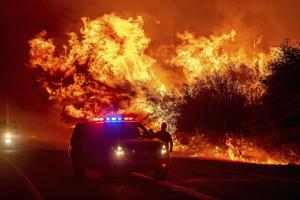Newsom to visit Berry Creek area devastated by North Complex fire

(The Center Square) – As California Gov. Gavin Newsom prepared to visit a critical fuel project in Berry Creek Tuesday, critics argue the North Complex wildfire might have been mitigated were it not for California’s excessive environmental regulations and red tape.
“I’m glad that the governor is touring my district today,” state Assemblyman James Gallagher, R-Yuba City, tweeted Tuesday. “I hope that he learns more about how (CEQA) held up a critical fuel reduction project in Berry Creek before the area was savaged by the North Complex fire last year. If the governor is serious about solutions, he could support my legislation to remove roadblocks like this that stop critical fire prevention projects.”
Two years before a deadly fire leveled Berry Creek, burning 273,000 acres and killing approximately 15 people, it was supposed to have received an $836,000 state grant to enable it to prune vegetation and clear fuel from potential fire spots. But it never received the money because of red tape, local officials argue, as reported by the San Francisco Chronicle.
“I can’t guarantee that it would’ve stopped the fire, but it would have given them a place to fight it,” Bill Connelly, a Butte County supervisor representing the district that includes Berry Creek, told the Chronicle.
The funding would have enabled the county to thin and prune areas near Bald Rock and Rockefeller roads two critical evacuation routes, in addition to an area near Lake Madrone, ground zero for the North Complex Fire.
Stringent environmental reviews caused the delay for the county to receive the money even though it was being directed to efforts designed specifically to prevent fires. The reviews are too cumbersome and too time-consuming, critics argue, even requiring archaeological studies, landowner permission slips, bird surveys and more.
Connelly said the state needs to change the California Environmental Quality Act to leave the review process to the counties.
A representative from the governor’s office said Newsom signed an executive order selecting 35 fuel-management projects in some of the most fire-vulnerable communities in California to submit CEQA waivers. But Berry Creek was not on the list.
Meanwhile, Newsom’s revised budget clawed back $7.3 million in funding that was approved in last year’s budget to help keep the Paradise Irrigation District (PID) financially stable after its customer base was decimated in the 2018 Camp Fire, Gallagher said in a statement.
“It’s beyond the pale – taking funds from Camp Fire recovery,” Gallagher said. “… cutting off Paradise’s water supply in the middle of the Town’s recovery is a cold-hearted decision. $7 million won’t balance the budget but it means everything to this Town that has been through so much.”
State Sen. Jim Nielsen, R-Tehama, said, “Bringing back clean, reliable water is critical for the health and safety of residents who are rebuilding their lives. Without this funding, the Town of Paradise’s recovery effort may come to a halt.”
The two Republican state legislators, who represent Paradise and Camp Fire survivors, introduced legislation to help prevent wildfires. Their bill would temporarily pause the state’s renewable power mandates until infrastructure and vegetation management conditions are improved, and require that savings from a temporary relief fund be used by Investor Owned Utilities (IOUs) to harden the grid.
PG&E is currently spending roughly $2.4 billion annually to uphold a legislative mandate to buy renewable power but only $1.5 billion to update its century old infrastructure, Gallagher notes.
“A century-old transmission tower was cited as the ignition source of the Camp Fire, and a utility tower reportedly may also be the source of the Kincade Fire currently burning in Sonoma,” Gallagher said.
The legislators are also calling on freezing IOU executive compensation and putting any proposed bonuses on hold.
Nielsen says their approach would help end power shutoff events as well.
“We are not waiting ten years. No more power shutoffs. It needs to happen now,” Nielsen said. “Millions without electricity is what a third world country looks like, not a state that is the 5th largest economy in the world.”
California IOUs have already met their goals of reaching 33% renewable solar and wind energy, the legislators note, and PG&E is already producing 85% of its power from renewable and carbon-free sources. Every dollar spent on additional renewable energy costs, they argue, is money that could have otherwise been spent on vegetation management, line insulation, undergrounding, and other grid-hardening measures.
“Dollars spent on forestry management have been found to do more to reduce carbon than other measures. Science shows that redirecting funding to forestry management gets us a better bang for our buck in carbon reduction,” Gallagher said.
Last September, Newsom declared a statewide emergency in response to the widespread fires and extreme weather conditions and secured a Major Disaster Declaration from the Trump administration to bolster the state’s emergency response.
California also secured Fire Management Assistance Grants from the Federal Emergency Management Agency to support the state’s response to fires burning in Santa Clara, Stanislaus, Santa Cruz, San Mateo, Napa, Nevada, Lake, Solano, Yolo, Monterey, Fresno, Madera, San Bernardino, Siskiyou, Butte, Plumas and Yuba counties.
Disclaimer: This content is distributed by The Center Square


